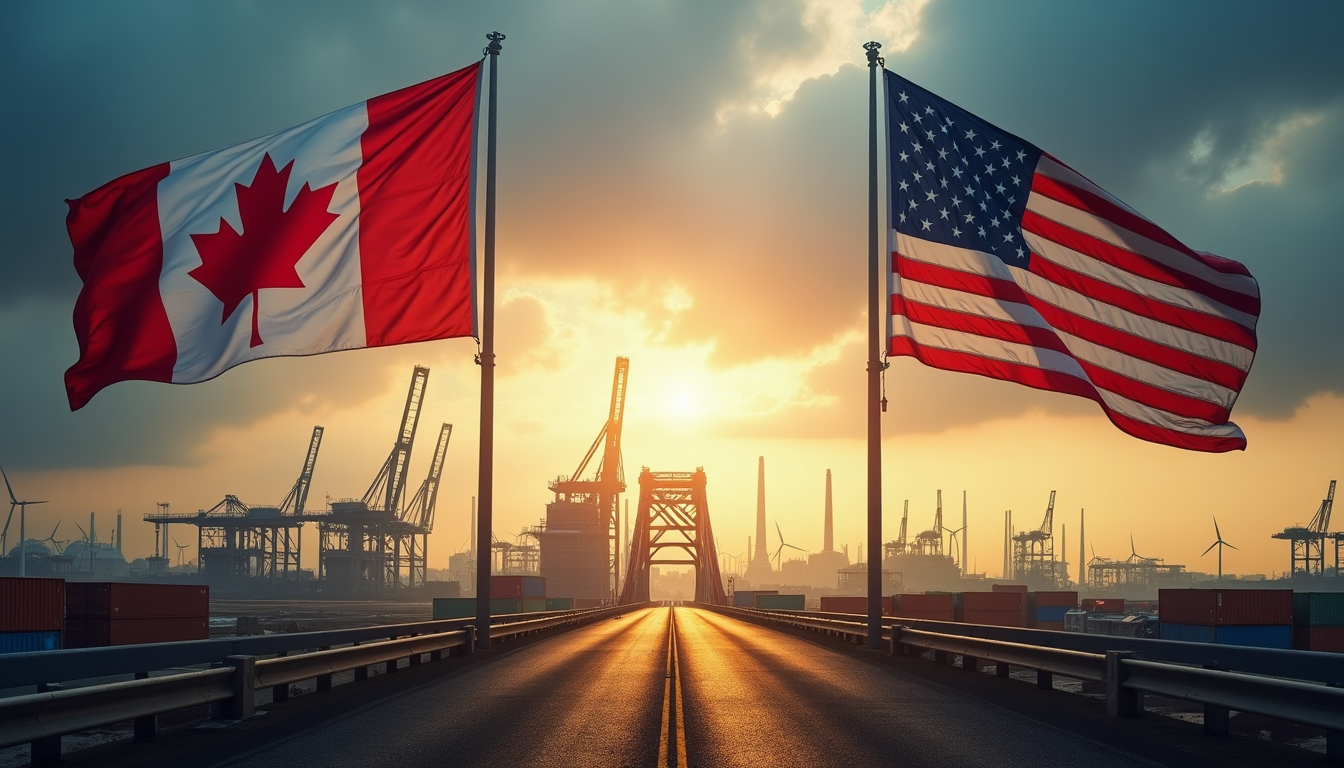Pierre Poilievre's Bold Stance: Why He Won't Let Canada Bow to US Tariffs

Pierre Poilievre stands firm against mounting trade pressures as tensions escalate between Canada and its largest trading partner. Amid recent US tariffs threatening Canadian industries, the Conservative leader's unwavering position has sparked significant debate across the nation.
The complex trade relationship between Canada and the US faces a critical turning point, specifically in energy exports and industrial sectors. This stance reflects broader questions about Canadian economic sovereignty and the future of cross-border trade relations.
This analysis examines Poilievre's economic vision, explores the energy export challenges, evaluates potential responses to US tariffs, and addresses the crucial need for provincial unity in facing these trade pressures.
Understanding Poilievre's Economic Vision
At the core of Poilievre's economic approach lies a commitment to deregulation and tax reduction, aimed at unleashing private sector growth [1].
Key elements of his trade strategy
The Conservative leader's trade strategy centers on building a more resilient Canadian economy. His plan includes cutting bureaucracy, reducing foreign aid, and eliminating corporate welfare [2]. Additionally, Poilievre advocates for swift reforms in key sectors:
- Accelerating approvals for energy infrastructure
- Streamlining mining permit processes
- Expanding nuclear power development
- Strengthening border security measures
Criticism of current trade policies
Poilievre points to significant economic challenges under current policies. Canadian manufacturing has declined markedly, with 15 of 18 industries showing contraction [3]. Furthermore, he highlights that Canada sells oil to American markets at CAD 20.90 below market price per barrel [4], resulting in substantial revenue losses.
Vision for Canadian economic independence
The Conservative leader's vision for economic independence focuses on reducing dependence on US markets. His proposed reforms include fast-tracking LNG plant approvals on the West Coast and developing alternative export routes [5]. Meanwhile, Poilievre emphasizes Canada's strategic advantages, including shorter shipping routes to Asia and Europe compared to American competitors [5].
Nevertheless, this vision faces practical challenges. Annual interest payments on accumulated debt are projected to reach CAD 97.54 billion by decade's end [6]. To address this, Poilievre proposes eliminating the CAD 48.77-billion Canada Infrastructure Bank [6] and redirecting resources toward core economic priorities.
The plan also addresses housing affordability through targeted measures. Under his proposal, cities would need to increase housing construction by 15% annually or face reduced federal grants [2]. This approach aims to tackle what he terms "housing hell" - a crisis despite CAD 121.22 billion in federal allocations since 2015 [6].
The Energy Export Dilemma
The energy trade relationship between Canada and the United States reached unprecedented levels, with bilateral energy trade hitting CAD 264.74 billion in 2022 [7].
Current US-Canada energy trade dynamics
Canada maintains a significant surplus in energy commodity trade with the United States, exporting nearly four times more than it imports [8]. The trade dynamics highlight several key metrics:
- U.S. crude oil imports from Canada averaged 3.7 million barrels per day in 2022 [7]
- Natural gas imports to the U.S. stood at 7.6 billion cubic feet per day [7]
- Overall energy exports from Canada to the U.S. totaled CAD 217.78 billion [7]
Impact of pipeline limitations
Pipeline constraints have essentially created substantial economic challenges. The lack of sufficient transportation capacity has forced Canadian producers to sell oil at significantly discounted prices, with the differential reaching USCAD 69.67 per barrel in late 2018 [9]. Consequently, these constraints resulted in lost revenues exceeding CAD 8.36 billion in provincial royalties between 2010 and 2016 [10].
Proposed solutions for energy independence
Rather than remaining dependent on U.S. markets, solutions focus on expanding infrastructure. The Trans Mountain Expansion Project primarily aims to increase pipeline capacity from 300,000 to 890,000 barrels per day [9]. Moreover, the development of LNG plants and additional export infrastructure could generate over 14,000 jobs and contribute CAD 76.63 billion to Canada's GDP [10].
The expansion efforts, overall, face significant regulatory hurdles. Pipeline development has slowed considerably due to local environmental concerns and broader climate change considerations [8]. These challenges have prompted Canadian stakeholders to seek expanded outlets through the east and west coasts [8].
Strategic Response to US Tariffs
Canada's strategic response to potential US tariffs takes shape through a multi-tiered approach. The federal government has prepared an initial counter-tariff package worth CAD 51.55 billion [11], with additional measures potentially reaching CAD 153.27 billion [11].
Potential retaliatory measures
In response to US trade pressures, Canada's immediate strategy involves targeted counter-tariffs on high-profile American products. The first wave would affect approximately ten prominent items, notably Florida orange juice and Kentucky bourbon [12]. The government plans a consultation period of 15-30 days before implementing these measures [11].
Protection of Canadian industries
The federal government's protective strategy encompasses several key measures:
- Emergency relief programs to prevent layoffs and sustain operations [13]
- Enhanced income support systems similar to COVID-19 assistance [13]
- Preferential loan guarantees for export-dependent firms [13]
- Expanded Canadian Work-Share programs [13]
Building international trade alternatives
Canada actively pursues trade diversification beyond the US market. Through its Export Diversification Strategy, the nation aims to increase overseas exports by 50% by 2025 [1]. The country currently maintains 15 free trade agreements with 49 countries [1], accordingly positioning itself as a global trade hub.
The automotive supply chain presents particular challenges, with nearly 20% of intermediary goods sourced from the US [14]. However, certain sectors show promising resilience - metal ores and non-metallic minerals export only 25% to the US market [14]. Subsequently, Canada strengthens ties with alternative trading partners, particularly Mexico, the EU, and Japan [14].
In particular, Canada continues negotiations with growing markets in South America, including the Pacific Alliance and Mercosur bloc [1]. As a result, these diversification efforts aim to reduce dependency on any single market while maintaining economic stability during trade disputes.
Provincial Unity Challenge
Across Canada's provinces, divergent approaches emerge in response to looming US trade pressures. British Columbia's preliminary assessment indicates potential losses of CAD 96.14 billion in economic activity between 2025 and 2028 [15].
Divided provincial responses
Provincial unemployment projections vary significantly, with British Columbia anticipating rates climbing to 6.7% in 2025 and 7.1% in 2026 [15]. First of all, corporate profits could decline annually between CAD 5.02 billion to CAD 8.50 billion [15]. Ontario and British Columbia primarily focus on diversifying trade relationships, using Asia-Pacific networks to reduce US market dependence [15].
Alberta's unique position
Alberta stands out as a crucial player in Canada's economic landscape. The province serves as the largest foreign supplier of energy products to the US [16]. Alberta's international offices actively promote the province's economic interests through:
- Strategic growth opportunities in global markets
- International trade mission coordination
- Management of foreign official visits
- Building international partnerships [16]
Building consensus across Canada
Ultimately, the federal government maintains active dialog with provincial governments to develop trade policy positions [17]. Presently, the effectiveness of intergovernmental cooperation depends heavily on the government's approach [18]. The provinces have assumed a more active role in trade negotiations [18], although Canada lacks constitutional requirements for provincial approval of international treaties [18].
British Columbia's three-part strategy exemplifies provincial adaptation: respond to tariffs through contingency planning, strengthen domestic positions through expedited permitting, and diversify trade relationships [15]. This approach aligns with broader national efforts to coordinate retaliation if necessary [11].
Conclusion
Pierre Poilievre's resolute position against US tariffs marks a significant shift in Canada's approach to trade relations. Through targeted deregulation and strategic infrastructure development, his economic vision aims to strengthen Canadian sovereignty while maintaining crucial trade partnerships.
Evidence suggests these policies could yield substantial benefits. Streamlined approvals for energy projects, coupled with expanded LNG facilities, promise to reduce dependence on US markets. Meanwhile, Canada's prepared counter-tariff package worth CAD 51.55 billion demonstrates readiness to protect domestic industries.
Provincial coordination remains essential for success. British Columbia's three-part strategy exemplifies effective regional planning, though different provinces face unique challenges. Alberta's position as America's largest foreign energy supplier adds complexity to the national response.
Canadian economic independence hinges on balanced trade relationships and infrastructure development. Strategic diversification efforts, including 15 free trade agreements spanning 49 countries, provide alternatives beyond US markets. This multi-faceted approach, supported by provincial cooperation, positions Canada to navigate trade pressures while protecting its economic interests.
References
[1] - https://www.international.gc.ca/gac-amc/campaign-campagne/trade-diversification-commerce/index.aspx?lang=eng
[2] - https://www.cbc.ca/news/politics/poilievre-jordan-peterson-interview-1.7423197
[3] - https://www.icbaindependent.ca/2025/01/16/news-release-icba-endorses-pierre-poilievre-and-his-vision-for-building-canada/
[4] - https://cheknews.ca/i-will-retaliate-poilievre-says-trumps-planned-tariffs-would-hurt-u-s-and-canadian-citizens-1233659/
[5] - https://www.nationalobserver.com/2025/01/15/news/pierre-poilievre-promises-patriotism-vague-us-tariff-threat
[6] - https://www.thestar.com/business/opinion/can-canadians-trust-pierre-poilievre-with-the-economy-here-are-some-of-the-major-changes/article_2f546ea8-6eb5-11ef-889c-e35aa8ab45ab.html
[7] - https://enerknol.com/energy-trade-between-u-s-and-canada-reaches-record-high-during-2022-eia/
[8] - https://www.csis.org/analysis/mapping-us-canada-energy-relationship
[9] - https://www.cer-rec.gc.ca/en/data-analysis/facilities-we-regulate/canadas-pipeline-system/2021/crude-oil-pipeline-transportation-system.html
[10] - https://www.canadianenergycentre.ca/making-canadian-oil-prices-more-equal-examining-the-facts-about-increased-pipeline-access/
[11] - https://www.cbc.ca/news/politics/canada-retaliatory-tariffs-1.7434137
[12] - https://www.bnnbloomberg.ca/business/economics/2025/01/16/canadas-counter-tariff-plan-would-target-us-aluminum-steel/
[13] - https://www.unifor.org/news/all-news/letter-prime-minister-trudeau-considering-canadas-response-us-tariffs
[14] - https://economics.td.com/ca-trump-tariffs
[15] - https://news.gov.bc.ca/releases/2025FIN0002-000019
[16] - https://www.alberta.ca/country-regional-relations
[17] - https://international.canada.ca/en/global-affairs/services/trade/policy/about
[18] - https://irpp.org/wp-content/uploads/2018/10/Federalism-and-International-Trade-Policy-The-Canadian-Provinces-in-Comparative-Perspective.pdf
